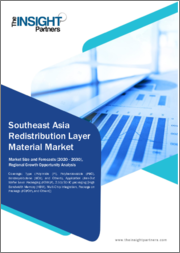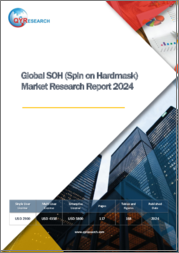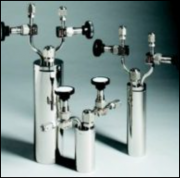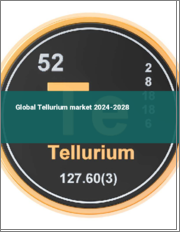
|
시장보고서
상품코드
1372561
동남아시아의 재분배층 재료 시장 규모 및 예측, 지역 점유율, 동향, 성장 기회 분석 리포트 수록 범위 : 유형별, 용도별Southeast Asia Redistribution Layer Material Market Size and Forecasts, Regional Share, Trends, and Growth Opportunity Analysis Report Coverage: By Type and Application |
||||||
동남아시아의 재분배층 재료 시장은 2022년 5,451만 달러에서 2030년에는 1억 5,011만 달러로 성장할 것으로 예측되며, 2022-2030년의 CAGR은 13.5%로 예측됩니다.
재분배층(RDL)은 집적회로(IC) 또는 반도체 소자에서 전기 신호의 경로와 재분배에 사용되는 전도성 물질의 박막 또는 층입니다. 이 층은 IC의 트랜지스터, 커패시터, 저항과 같은 부품을 연결하고 이들 사이에 신호가 효율적으로 흐르도록 하는 데 필수적입니다. 동남아시아는 이러한 수요의 혜택을 누릴 수 있는 전략적 위치에 있습니다. 이 지역은 말레이시아, 베트남, 태국 등의 국가들이 중요한 시설을 갖추고 있으며, 반도체 제조 및 조립의 허브로 부상하고 있습니다. 이러한 생산 기지가 주요 산업과 가깝다는 것은 재분배층 재료의 효율적이고 비용 효율적인 조달이 가능하다는 것을 의미합니다. 또한 자동차 및 통신 부문의 경제 성장은 전체 공급망에 파급 효과를 가져오고 있습니다. R&D, 기술 및 인프라에 대한 투자가 증가하면서 재분배층 재료 분야의 혁신과 개발에 도움이 되는 환경이 조성되고 있습니다. 이러한 추세의 특징은 생산량 증가, 첨단 포장 기술, 소형화 요구, 이 지역의 전략적 공급망 위치, 전체 생태계에 미치는 긍정적인 경제적 효과입니다. 이러한 요인들이 종합적으로 동남아시아 재분배층 재료 시장의 성장을 가속하고 있습니다.
반도체 업계는 비용 절감을 위해 항상 혁신적인 솔루션을 개발하기 위해 노력해 왔습니다. 현재 주요 반도체 제조업체들이 고려하고 있는 접근 방식 중 하나는 웨이퍼 및 스트립 크기에서 IC 조립 전용 대형 패널로 전환하는 것입니다. 효율성과 규모의 경제는 이 길의 부가가치입니다. 팬아웃 패키지 제조를 웨이퍼에서 대형 패널로 전환하는 FOWLP(Fan-Out Wafer Level Packaging)에서 FOPLP(Fan-Out Panel Level Packaging)로의 전환은 더 널리 채택될 수 있는 솔루션이 될 수 있습니다. 소비자 전자제품, 차량용 시스템, 산업용 장비의 소형화 및 복잡성 증가에 따라 첨단 반도체 포장 기술에 대한 요구가 증가하고 있습니다. 재분배층은 이 공정에 필수적인 요소로, 더 작은 폼팩터로 접을 수 있고, 기능성을 높이고 성능을 향상시킬 수 있습니다. 동남아시아 제조업체는 필요한 재료를 생산하고 공급함으로써 이러한 추세를 활용할 수 있는 위치에 있습니다. 포장 산업의 발전, 특히 2.5D 및 3D 포장 기술의 채택은 동남아시아의 배선층 재료 시장 성장의 중요한 촉진제가 될 것으로 예상되며, 2.5D 및 3D 포장 기술은 칩 밀도와 기능성을 크게 향상시킬 것입니다. 여러 개의 반도체 다이를 서로 또는 옆으로 쌓아 올리면 이러한 기술은 보다 견고하고 컴팩트한 전자 장비를 가능하게 합니다. 리배선 층은 이러한 적층 또는 인접한 다이 사이의 상호 연결을 형성하여 효율적인 데이터 전송 및 전기 연결을 보장하는 데 필수적입니다. 동남아시아는 반도체 제조 전문성을 활용하여 이러한 첨단 포장 기술에 필요한 중요한 리배선층 재료를 공급할 수 있습니다.
이러한 포장 기술은 성능 및 에너지 효율 향상 측면에서 주목할 만한 이점을 제공하며, 2.5D 및 3D 포장은 상호 연결 길이가 짧아지고 신호 경로가 짧아져 데이터 처리 속도가 빨라지고 전력 소비를 줄일 수 있습니다. 이에 따라 신호 무결성과 열 관리를 유지할 수 있는 재분배층 재료에 대한 수요가 더욱 중요해집니다. 동남아시아는 세계 산업계 수요를 충족시키기 위해 이러한 첨단 소재 공급에 있으며, 매우 중요한 역할을 할 수 있습니다. 또한 자동차 업계는 첨단운전자보조시스템(ADAS)와 자율주행 기술의 통합을 위해 2.5D 및 3D 포장을 채택하고 있습니다. 이러한 용도는 긴밀하게 통합된 고성능 반도체 패키지에 의존하고 있으며, 이를 위해서는 신뢰할 수 있는 배선층 재료가 필요합니다. 동남아시아는 자동차용 일렉트로닉스 제조에서 강력한 입지를 가지고 있으며, 동남아시아의 리와이어링 레이어 재료 시장 성장에 주요한 기여를 하고 있습니다.
세계 제조업체들이 새로운 포장 기술을 개발하고 있습니다. 예를 들어 2021년 5월 Samsung Electronics는 고성능 컴퓨팅(HPC)에서 AI, 5G, 클라우드, 대규모 데이터센터, 고속 통신, 이기종 집적화를 통한 로직과 메모리 간 전력 효율 개선 등을 실현하는 I-Cube4를 발표했습니다. 또한 2023년 9월, ASIC 설계 서비스 및 IP 프로바이더인 패러데이 테크놀러지(Faraday Technology Co., Ltd.)는 2.5D/3D 고급 패키지 서비스를 시작한다고 발표했습니다. 프로세서 등의 HPC를 대상으로 최고 성능을 달성하기 위해 사용됩니다. 이러한 포장 기술의 발전은 동남아시아의 재분배층 재료 시장의 성장을 가속할 것으로 예상됩니다.
동남아시아의 재분배층 재료 시장에 참여하고 있는 주요 기업은 Advanced Semiconductor Engineering, Inc, Amkor Technology, Fujifilm Corporation, DuPont, Infineon Technologies AG, NXP Semiconductors, Samsung Electronics Co.Ltd, 신에츠 화학산업, SK Hynix Inc, Jiangsu Changjiang Electronics Technology Co.Ltd 등입니다. 동남아시아의 재분배층 재료 시장에서 사업을 운영하는 기업은 고객의 요구를 충족하기 위해 고품질·혁신적인 제품의 개발에 주력하고 있습니다.
동남아시아의 재분배층 재료 시장 전체의 규모는 1차 정보와 2차 정보 양측을 이용해서 도출된 것입니다. 동남아시아의 재분배층 재료 시장에 관련된 질적·양적 정보를 입수하기 위해 사내외 정보원을 이용해 철저한 2차 조사를 시행했습니다. 또한 데이터를 검증하고, 토픽에 관한보다 상세 분석적 인사이트를 얻기 위해 업계 관계자에게 복수의 1차 인터뷰를 시행했습니다. 이 프로세스 참여 기업에는 부사장, 시장 개척 매니저, 시장 정보 매니저, 국내 영업 매니저 등의 업계 전문가와 동남아시아의 재분배층 재료 시장을 전문으로 하는 평가 전문가, 조사 애널리스트, 키 오피니언 리더 등의 외부 컨설턴트가 포함됩니다.
목차
제1장 서론 12
- The Insight Partners 조사 보고서 가이던스 12
- 시장 세분화 13
제2장 주요 요약 14
- 주요 인사이트 14
- 시장의 매력 15
제3장 조사 방법 16
- 조사 대상 범위 17
- 2차 조사.18
- 1차 조사.18
제4장 동남아시아의 재분배층 재료 시장 구도 19
- 개요 19
- Porter's Five Forces 분석 20
- 공급 기업의 교섭력.20
- 구매자의 교섭력.21
- 신규 진출업체의 위협.21
- 경쟁 기업간 경쟁 관계.21
- 대체품의 위협.22
- 에코시스템 분석.23
- 원재료 공급업체.23
- 제조업체.23
- 최종 용도 24
- 밸류체인 벤더 리스트 25
제5장 동남아시아의 재분배층 재료 시장 : 주요 시장 역학 27
- 시장 촉진요인 27
- AI 기반 기기와 툴에 대한 주목의 증가.27
- 자동차 산업과 통신 산업으로부터의 수요 증가.28
- 시장 억제요인.29
- 원재료 가격의 변동.29
- 시장 기회.30
- 업계별 IoT와 커넥티드 디바이스의 보급.30
- 향후 동향.30
- 포장 기술 첨단화.30
- 영향 분석.32
제6장 재배포층 재료 시장 - 동남아시아 시장 분석 33
- 동남아시아의 재분배층 재료 시장 판매고 33
- 동남아시아의 재분배층 재료 시장 수량 34
- 동남아시아의 재분배층 재료 시장 예측과 분석 35
제7장 동남아시아의 재분배층 재료 시장 분석 - 유형 36
- 폴리이미드(PI) 38
- 개요 38
- 폴리이미드(PI) 시장 규모 추이와 2030년까지의 예측 39
- Polybenzoxazole(PBO) 39
- 개요 39
- Polybenzoxazole(PBO) 시장 규모 추이와 2030년까지의 예측 40
- Benzocylobutene(BCB) 41
- 개요 41
- Benzocylobutene(BCB) 시장 수량과 2030년까지의 예측 42
- 기타 42
- 개요 42
- 기타 시장 규모 추이와 2030년까지의 예측 44
제8장 동남아시아의 재분배층 재료 시장 분석 - 용도 45
- FOWLP(Fan-Out Wafer Level Packaging) 46
- 개요 46
- FOWLP(Fan-Out Wafer Level Packaging) 시장 매출과 2030년까지의 예측 47
- 2.5D/3D IC 포장 48
- 개요.48
- 2.5D/3D IC 패키지 시장 매출과 2030년까지의 예측 48
제9장 동남아시아의 재분배층 재료 시장 : 지역별 분석 49
- 동남아시아의 재분배층 재료 시장 49
- 개요 49
- 동남아시아의 재분배층 재료 시장 : 국가별 내역 4950
- 재분배층 재료 국가별 시장 내역.50
- 인도네시아의 재분배층 재료 시장 규모 추이와 2030년까지의 예측 51
- 싱가포르의 재분배층 재료 시장 규모 추이와 2030년까지의 예측 54
- 말레이시아의 재분배층 재료 시장 규모 추이와 2030년까지의 예측 57
- 대만의 재분배층 재료 시장 규모 추이와 2030년까지의 예측 60
- 태국의 재분배층 재료 시장 규모 추이와 2030년까지의 예측 63
- 베트남의 재분배층 재료 시장 규모 추이와 2030년까지의 예측 66
- 기타 동남아시아의 재분배층 재료 시장 규모 추이와 2030년까지의 예측 69
제10장 COVID-19 팬데믹 동남아시아 재분배층 재료 시장에 대한 영향 72
- COVID-19 전후의 영향 72
제11장 경쟁 구도 73
- 주요 기업별 히트맵 분석 73
- 기업의 포지셔닝과 집중도 73
제12장 업계 상황 74
- 개요 74
- 시장 구상 74
- 신제품 개발 75
- 합병과 인수 75
제13장 기업 개요
- SK Hynix Inc. 76
- Samsung Electronics Co Ltd. 80
- Infineon Technologies AG. 84
- DuPont de Nemours Inc. 88
- FUJIFILM Holdings Corp. 92
- Amkor Technology Inc. 96
- ASE Technology Holding Co Ltd. 100
- NXP Semiconductors NV. 104
- JCET Group Co Ltd. 108
- Shin-Etsu Chemical Co Ltd. 112
제14장 부록 116
KSA 23.11.09The Southeast Asia redistribution layer material market is expected to grow from US$ 54.51 million in 2022 to US$ 150.11 million by 2030; it is expected to grow at a CAGR of 13.5% from 2022 to 2030.
The redistribution layer (RDL) is the thin film or layer of conductive material used to route and redistribute electrical signals within an integrated circuit (IC) or semiconductor device. This layer is essential for connecting components, such as transistors, capacitors, and resistors, within the IC and ensuring that signals can flow efficiently between them. Southeast Asia is strategically positioned to benefit from this demand. The region has emerged as a semiconductor manufacturing and assembly hub, with countries such as Malaysia, Vietnam, and Thailand hosting significant facilities. The proximity of these production centers to the key industries means that sourcing redistribution layer materials is efficient and cost-effective. Additionally, the economic growth of the automotive and telecommunications sectors has a ripple effect on the entire supply chain. Investments in research and development, technology, and infrastructure are increasing, fostering an environment conducive to innovation and development in the field of redistribution layer materials. This trend is characterized by increased production, advanced packaging technologies, miniaturization requirements, the region's strategic supply chain position, and a positive economic impact on the entire ecosystem. These factors collectively propel the Southeast Asia redistribution layer material market growth.
In the quest for cost reduction, the semiconductor industry has always been involved in developing innovative solutions. One approach currently considered by the leading semiconductor players is the migration from wafer and strip size to large-size panels dedicated to IC assembly. Efficiency and economies of scale are the added value of this path. Moving fan-out package manufacturing from a wafer, Fan-Out Wafer Level Packaging (FOWLP) to a large-scale panel, Fan-Out Panel Level Packaging (FOPLP), could be the solution for a wider adoption. As consumer electronics, automotive systems, and industrial devices become more compact and complex, there is a growing need for advanced semiconductor packaging technologies. Redistribution layers are integral to this process, it enables the creasing of smaller form factors, increases functionality and improves performance. Manufacturers in Southeast Asia are positioned to capitalize on this trend by producing and supplying the necessary materials. Advancements in the packaging industries, specifically the adoption of 2.5D and 3D packaging technologies, are poised to be significant drivers of the Southeast Asia redistribution layer material market growth. 2.5D and 3D packaging technologies significantly increase chip density and functionality. By stacking multiple semiconductors die on each other or side by side, these technologies allow for more robust and compact electronic devices. Redistribution layers are essential for creating interconnections between these stacked or adjacent dies, ensuring efficient data transfer and electrical connectivity. Southeast Asia can leverage semiconductor manufacturing expertise to supply the critical redistribution layer materials required for these advanced packaging techniques.
These packaging technologies offer notable advantages in terms of improved performance and energy efficiency. With 2.5D and 3D packaging, shorter interconnect lengths and reduced signal paths contribute to faster data processing and lower power consumption. As a result, demand for redistribution layer materials capable of maintaining signal integrity and thermal management becomes even more crucial. Southeast Asia can play a pivotal role in delivering these advanced materials to meet global industry demands. Furthermore, the automotive industry is embracing 2.5D and 3D packaging to enable the integration of advanced driver-assistance systems (ADAS) and autonomous driving technologies. These applications rely on tightly integrated, high-performance semiconductor packages that demand reliable redistribution layer materials. Southeast Asia's strong presence in automotive electronics manufacturing positions it as a key contributor to the Southeast Asia redistribution layer material market growth.
Manufacturers across the globe are developing new packaging technologies. For instance, in May 2021, Samsung Electronics launched I-Cube4, for High-Performance Computing (HPC) to AI, 5G, cloud, and large data center, fast communication, and improving power efficiency between logic & memory through heterogeneous integration. In addition, in September 2023, Faraday Technology Corporation, an ASIC design service, and IP provider, announced the launch of its 2.5D/3D advanced package service. The 2.5D package technology is used for achieving the highest performance, targeting HPC such as AI accelerator, graph processing unit, and networking processor. Such advancements in packaging technology are expected to bolster the Southeast Asia redistribution layer material market growth.
A few key players operating in the Southeast Asia redistribution layer material market are Advanced Semiconductor Engineering, Inc; Amkor Technology; Fujifilm Corporation; DuPont; Infineon Technologies AG; NXP Semiconductors; Samsung Electronics Co., Ltd; Shin-Etsu Chemical Co., Ltd; SK Hynix Inc; and Jiangsu Changjiang Electronics Technology Co., Ltd. Players operating in the Southeast Asia redistribution layer material market are highly focused on developing high-quality and innovative product offerings to fulfill customers' requirements.
The overall Southeast Asia redistribution layer material market size has been derived using both primary and secondary sources. Exhaustive secondary research has been conducted using internal and external sources to obtain qualitative and quantitative information related to the Southeast Asia redistribution layer material market. Also, multiple primary interviews have been conducted with industry participants to validate the data and gain more analytical insights into the topic. The participants of this process include industry experts, such as VPs, business development managers, market intelligence managers, and national sales managers-along with external consultants, such as valuation experts, research analysts, and key opinion leaders-specializing in the Southeast Asia redistribution layer material market.
Reasons to Buy:
- Progressive industry trends in the Southeast Asia redistribution layer material market to help players develop effective long-term strategies
- Business growth strategies adopted by developed and developing markets
- Quantitative analysis of the Southeast Asia redistribution layer material market from 2020 to 2030
- Estimation of the demand for redistribution layer material across various industries
- Porter’s five forces analysis provide a 360-degree view of the Southeast Asia redistribution layer material market
- Recent developments to understand the competitive market scenario and the demand for redistribution layer material in the Southeast Asia scenario.
- Market trends and outlook coupled with factors driving and restraining the growth of the Southeast Asia redistribution layer material market.
- Decision-making process by understanding strategies that underpin commercial interest concerning the Southeast Asia redistribution layer material market growth
- The Southeast Asia redistribution layer material market size at various nodes of market
- Detailed overview and segmentation of the Southeast Asia redistribution layer material market as well as its dynamics in the industry
- The Southeast Asia redistribution layer material market size in different regions with promising growth opportunities
Table Of Contents
1. Introduction 12
- 1.1 The Insight Partners Research Report Guidance. 12
- 1.2 Market Segmentation. 13
2. Executive Summary 14
- 2.1 Key Insights. 14
- 2.2 Market Attractiveness. 15
3. Research Methodology 16
- 3.1 Coverage. 17
- 3.2 Secondary Research. 18
- 3.3 Primary Research. 18
4. Southeast Asia Redistribution Layer Material Market Landscape 19
- 4.1 Overview. 19
- 4.2 Porter's Five Forces Analysis. 20
- 4.2.1 Bargaining Power of Suppliers. 20
- 4.2.2 Bargaining Power of Buyers. 21
- 4.2.3 Threat of New Entrants. 21
- 4.2.4 Intensity of Competitive Rivalry. 21
- 4.2.5 Threat of Substitutes. 22
- 4.3 Ecosystem Analysis. 23
- 4.3.1 Raw Material Suppliers. 23
- 4.3.2 Manufacturers. 23
- 4.3.3 End Use. 24
- 4.3.4 List of Vendors in the Value Chain: 25
5. Southeast Asia Redistribution Layer Material Market - Key Market Dynamics 27
- 5.1 Market Drivers. 27
- 5.1.1 Growing Focus on AI-based Equipment and Tools. 27
- 5.1.2 Increasing Demand from Automotive and Telecommunication Industries. 28
- 5.2 Market Restraints. 29
- 5.2.1 Fluctuation in Raw Material Prices. 29
- 5.3 Market Opportunities. 30
- 5.3.1 Proliferation of IoT and Connected Devices Across Industry Verticals. 30
- 5.4 Future Trends. 30
- 5.4.1 Advancements in the Packaging Technology. 30
- 5.5 Impact Analysis. 32
6. Redistribution Layer Material Market - Southeast Asia Market Analysis 33
- 6.1 Southeast Asia Redistribution Layer Material Market Revenue (US$ Million) 33
- 6.2 Southeast Asia Redistribution Layer Material Market Volume (Tons) 34
- 6.3 Southeast Asia Redistribution Layer Material Market Forecast and Analysis. 35
7. Southeast Asia Redistribution Layer Material Market Analysis - Type 36
- 7.1 Polyimide (PI) 38
- 7.1.1 Overview. 38
- 7.1.2 Polyimide (PI) Market Revenue and Forecast to 2030 (US$ Million) 38
- 7.1.3 Polyimide (PI) Market Volume and Forecast to 2030 (Tons) 39
- 7.2 Polybenzoxazole (PBO) 39
- 7.2.1 Overview. 39
- 7.2.2 Polybenzoxazole (PBO) Market Revenue and Forecast to 2030 (US$ Million) 40
- 7.2.3 Polybenzoxazole (PBO) Market Volume and Forecast to 2030 (Tons) 40
- 7.3 Benzocylobutene (BCB) 41
- 7.3.1 Overview. 41
- 7.3.2 Benzocylobutene (BCB) Market Revenue and Forecast to 2030 (US$ Million) 41
- 7.3.3 Benzocylobutene (BCB) Market Volume and Forecast to 2030 (Tons) 42
- 7.4 Others. 42
- 7.4.1 Overview. 42
- 7.4.2 Others Market Revenue and Forecast to 2030 (US$ Million) 43
- 7.4.3 Others Market Volume and Forecast to 2030 (Tons) 44
8. Southeast Asia Redistribution Layer Material Market Analysis - Application 45
- 8.1 Fan-Out Wafer Level Packaging (FOWLP) 46
- 8.1.1 Overview. 46
- 8.1.2 Fan-Out Wafer Level Packaging (FOWLP) Market Revenue, and Forecast to 2030 (US$ Million) 47
- 8.2 2.5D/3D IC Packaging. 48
- 8.2.1 Overview. 48
- 8.2.2 2.5D/3D IC Packaging Market Revenue, and Forecast to 2030 (US$ Million) 48
9. Southeast Asia Redistribution Layer Material Market - Geographical Analysis 49
- 9.1 Southeast Asia Redistribution Layer Material Market 49
- 9.1.1 Overview. 49
- 9.1.2 Southeast Asia Redistribution Layer Material Market Breakdown by Country. 50
- 9.1.2.1 Redistribution Layer Material Market Breakdown by Country. 50
- 9.1.2.2 Indonesia Redistribution Layer Material Market Revenue and Forecasts To 2030 (US$ Million) 50
- 9.1.2.3 Indonesia Redistribution Layer Material Market Volume and Forecasts To 2030 (Tons) 51
- 9.1.2.3.1 Indonesia Redistribution Layer Material Market Breakdown by Type. 52
- 9.1.2.3.2 Indonesia Redistribution Layer Material Market Breakdown by Application. 53
- 9.1.2.4 Singapore Redistribution Layer Material Market Revenue and Forecasts To 2030 (US$ Million) 54
- 9.1.2.5 Singapore Redistribution Layer Material Market Volume and Forecasts To 2030 (Tons) 54
- 9.1.2.5.1 Singapore Redistribution Layer Material Market Breakdown by Type. 55
- 9.1.2.5.2 Singapore Redistribution Layer Material Market Breakdown by Application. 56
- 9.1.2.6 Malaysia Redistribution Layer Material Market Revenue and Forecasts To 2030 (US$ Million) 57
- 9.1.2.7 Malaysia Redistribution Layer Material Market Volume and Forecasts To 2030 (Tons) 57
- 9.1.2.7.1 Malaysia Redistribution Layer Material Market Breakdown by Type. 58
- 9.1.2.7.2 Malaysia Redistribution Layer Material Market Breakdown by Application. 59
- 9.1.2.8 Taiwan Redistribution Layer Material Market Revenue and Forecasts To 2030 (US$ Million) 60
- 9.1.2.9 Taiwan Redistribution Layer Material Market Volume and Forecasts To 2030 (Tons) 60
- 9.1.2.9.1 Taiwan Redistribution Layer Material Market Breakdown by Type. 61
- 9.1.2.9.2 Taiwan Redistribution Layer Material Market Breakdown by Application. 62
- 9.1.2.10 Thailand Redistribution Layer Material Market Revenue and Forecasts To 2030 (US$ Million) 63
- 9.1.2.11 Thailand Redistribution Layer Material Market Volume and Forecasts To 2030 (Tons) 63
- 9.1.2.11.1 Thailand Redistribution Layer Material Market Breakdown by Type. 64
- 9.1.2.11.2 Thailand Redistribution Layer Material Market Breakdown by Application. 65
- 9.1.2.12 Vietnam Redistribution Layer Material Market Revenue and Forecasts To 2030 (US$ Million) 66
- 9.1.2.13 Vietnam Redistribution Layer Material Market Volume and Forecasts To 2030 (Tons) 66
- 9.1.2.13.1 Vietnam Redistribution Layer Material Market Breakdown by Type. 67
- 9.1.2.13.2 Vietnam Redistribution Layer Material Market Breakdown by Application. 68
- 9.1.2.14 Rest of Southeast Asia Redistribution Layer Material Market Revenue and Forecasts To 2030 (US$ Million) 69
- 9.1.2.15 Rest of Southeast Asia Redistribution Layer Material Market Volume and Forecasts To 2030 (Tons) 69
- 9.1.2.15.1 Rest of Southeast Asia Redistribution Layer Material Market Breakdown by Type. 70
- 9.1.2.15.2 Rest of Southeast Asia Redistribution Layer Material Market Breakdown by Application. 71
10. Impact of COVID-19 Pandemic on Southeast Asia Redistribution Layer Material Market 72
- 10.1 Pre & Post Covid-19 Impact 72
11. Competitive Landscape 73
- 11.1 Heat Map Analysis By Key Players. 73
- 11.2 Company Positioning & Concentration. 73
12. Industry Landscape 74
- 12.1 Overview. 74
- 12.2 Market Initiative. 74
- 12.3 New Product Development 75
- 12.4 Merger and Acquisition. 75
13. Company Profiles 76
- 13.1 SK Hynix Inc. 76
- 13.1.1 Key Facts. 76
- 13.1.2 Business Description. 76
- 13.1.3 Products and Services. 77
- 13.1.4 Financial Overview. 77
- 13.1.5 SWOT Analysis. 79
- 13.1.6 Key Developments. 79
- 13.2 Samsung Electronics Co Ltd. 80
- 13.2.1 Key Facts. 80
- 13.2.2 Business Description. 80
- 13.2.3 Products and Services. 81
- 13.2.4 Financial Overview. 81
- 13.2.5 SWOT Analysis. 83
- 13.2.6 Key Developments. 83
- 13.3 Infineon Technologies AG. 84
- 13.3.1 Key Facts. 84
- 13.3.2 Business Description. 84
- 13.3.3 Products and Services. 85
- 13.3.4 Financial Overview. 85
- 13.3.5 SWOT Analysis. 87
- 13.3.6 Key Developments. 87
- 13.4 DuPont de Nemours Inc. 88
- 13.4.1 Key Facts. 88
- 13.4.2 Business Description. 88
- 13.4.3 Products and Services. 89
- 13.4.4 Financial Overview. 89
- 13.4.5 SWOT Analysis. 91
- 13.4.6 Key Developments. 91
- 13.5 FUJIFILM Holdings Corp. 92
- 13.5.1 Key Facts. 92
- 13.5.2 Business Description. 92
- 13.5.3 Products and Services. 93
- 13.5.4 Financial Overview. 93
- 13.5.5 SWOT Analysis. 95
- 13.5.6 Key Developments. 95
- 13.6 Amkor Technology Inc. 96
- 13.6.1 Key Facts. 96
- 13.6.2 Business Description. 96
- 13.6.3 Products and Services. 97
- 13.6.4 Financial Overview. 97
- 13.6.5 SWOT Analysis. 99
- 13.6.6 Key Developments. 99
- 13.7 ASE Technology Holding Co Ltd. 100
- 13.7.1 Key Facts. 100
- 13.7.2 Business Description. 100
- 13.7.3 Products and Services. 101
- 13.7.4 Financial Overview. 101
- 13.7.5 SWOT Analysis. 103
- 13.7.6 Key Developments. 103
- 13.8 NXP Semiconductors NV. 104
- 13.8.1 Key Facts. 104
- 13.8.2 Business Description. 104
- 13.8.3 Products and Services. 105
- 13.8.4 Financial Overview. 105
- 13.8.5 SWOT Analysis. 107
- 13.8.6 Key Developments. 107
- 13.9 JCET Group Co Ltd. 108
- 13.9.1 Key Facts. 108
- 13.9.2 Business Description. 108
- 13.9.3 Products and Services. 108
- 13.9.4 Financial Overview. 109
- 13.9.5 SWOT Analysis. 110
- 13.9.6 Key Developments. 111
- 13.10 Shin-Etsu Chemical Co Ltd. 112
- 13.10.1 Key Facts. 112
- 13.10.2 Business Description. 112
- 13.10.3 Products and Services. 113
- 13.10.4 Financial Overview. 113
- 13.10.5 SWOT Analysis. 114
- 13.10.6 Key Developments. 115



















